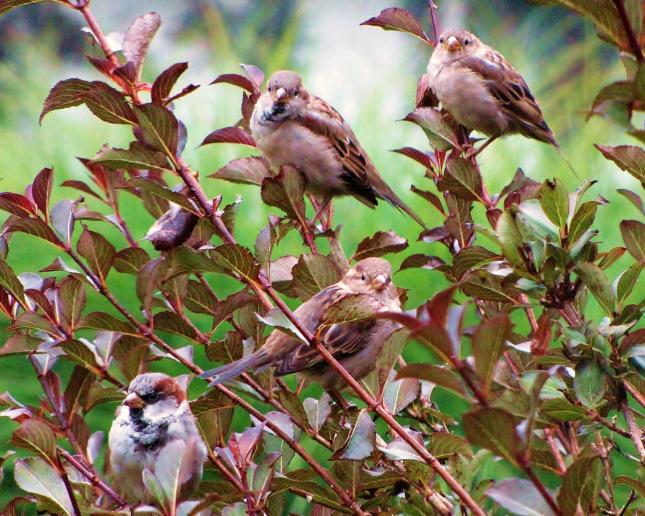Too Many House Sparrows?
"SO MANY SPARROWS!"
Late each summer and fall, we hear this comment many times a day from all of you who have feeders overtaken by house sparrows. You see, house sparrows are a non-native bird with some adaptability advantages over our native birds. By this time of year, most pairs of house sparrows have successfully raised at least three clutches of babies and the population is at its peak for the year. All those young mouths are now showing up at the easy food sources - your feeders - including feeders sparrows may not bother much at other times of year, like finch or seed cylinder feeders.
While there aren't many foods that are sparrow-proof, there are things they like more or less than others. We can use these to our advantage. I'll go over our top choices below, broken down by feeder category or seed type.
1. Hoppers, Tubes, and Trays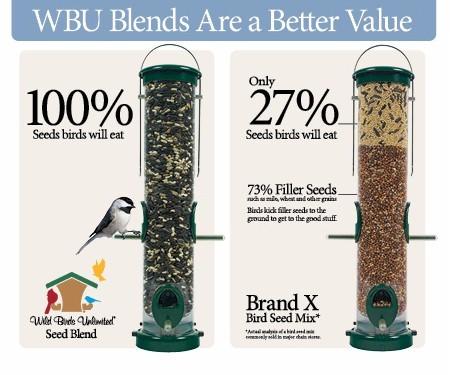
First - avoid the el-cheapo hardware/discount store blends ("Brand X" in photo). Most of these are filled with cheap grains like milo, wheat, and other things sparrows like, but few chickadees, cardinals, etc. will touch. These blends just invite sparrows.
Second - reduce use of white millet. Millet, not to be confused with milo (the reddish colored filler grain) is found in our Deluxe Blend and some No-Mess blends because it is actually a very good seed for attracting doves, juncos, towhees, and many of our ground feeding birds, but unfortunately it's also a house sparrow favorite. While you may still wish to offer it as part of a blend in a ground tray, avoiding it in a hopper or tube feeder will help discourage the sparrows from sitting on those feeders and kicking all the other seeds aside just to get the millet.
Seeds with harder shells and Safflower, make sparrows work harder and have reduced appeal. Again, they are not sparrow proof, but you might cut their numbers significantly. Our native birds don't mind working a bit harder to remove the shells.
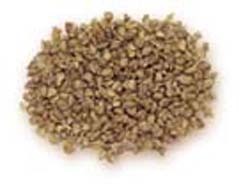
2. No-Mess / Tidy Seeds
Our shell-free No-Mess Blends are the most popular of all the blends we sell since they keep the landscape looking nice and attract many species of birds. Each of our No-Mess blends caters to a slightly different group of birds, and some of them have white millet in them, which is intended to purposely fall down to the ground feeding birds. However, millet is a favorite of sparrows and if they are kicking aside the sunflower chips and peanuts in the blend just to eat all the millet, try the No-Mess PLUS, which has no millet, or use straight Sunflower Chips. Sparrows will eat chips, but at a reduced rate. In the fall, after the deluge of sparrows has waned, you can go back to your usual No-Mess blend.
3. Bird Food Cylinders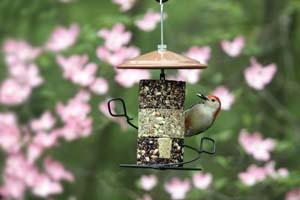
Most of the year, house sparrows seem a bit too lazy to want to work at chipping away on our bird food cylinders, but right now, all bets are off. However, there are two flavors that work pretty well:
Safflower is simply not a favorite of sparrows, and when it's compressed into the seed "log," it's even less so. This is perfect for your Cardinals, chickadees, and house finches (be sure you don't confuse the brown female and juvenile house finches with brown sparrows).
However, if you love your woodpeckers or blue jays, you'll want to stick with a cylinder that has nuts in it. Sparrows may nibble at it, but it seems to be more work than they want to go through so it does last longer. The woodpeckers, with their jackhammer beaks, think it's a breeze.
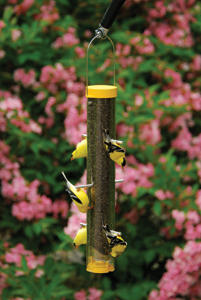
4. Finch Feeders
Most finch feeders are designed to attract finches, not necessarily to deter other species and for the majority of the year this works just fine because finch food is not a favorite of house sparrows. But at this time of year, when sparrows are greedy, they will eat finch food, too. Fortunately the Upside Down Finch Feeder (available in-store only) does a remarkable job of keeping most sparrows at bay. This feeder uses Goldfinches' natural abilities to hang by their toes as they feed from ripe sunflower heads and positions the feeding holes below the perches. The finches flip right over to feed, but most house sparrows don't have enough strength in their toes to do this.
We recommend keeping your traditional WBU finch feeders out too, since these are the most comfortable for your finches, but it won't take long for the finches to realize that if they get pushed off their favorite, that the upside down model is a very good option where they won't have to compete.
5. If you can't beat 'em, join em!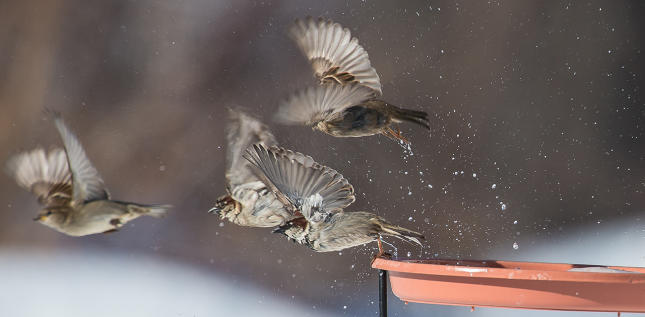
If you don't mind sharing, there is a something to be said for providing a place specifically for the house sparrows, ideally in combination with the deterrent steps outlined above. Offering Deluxe Blend or No-Mess CC (two blends that contain white millet) or straight White Millet in a tray style feeder can lure sparrows away from the other feeders. Tray feeders are ideal both because they offer more space and because they help contain the seeds when sparrow perform their natural seed sorting/flipping behaviors. When sparrows dine here, it frees up space at your other feeders. These trays also attract doves, juncos (in winter), and other ground feeding birds. Locate these sparrow feeding stations at least 10-15 feet away from your other feeders.


